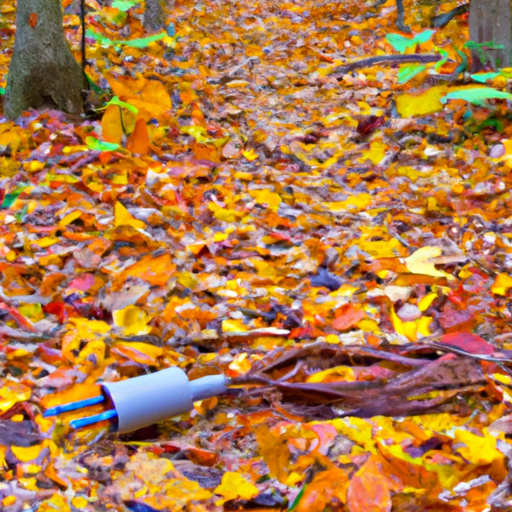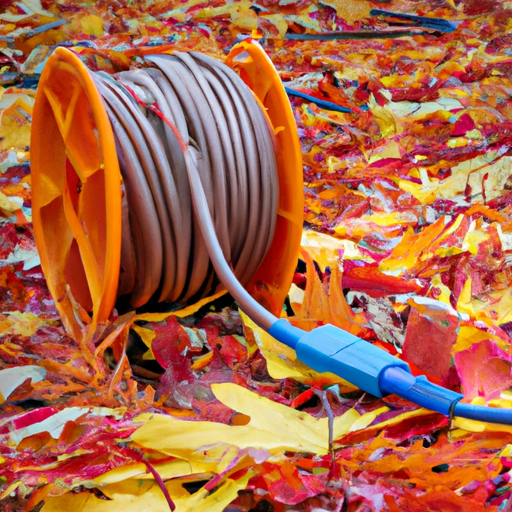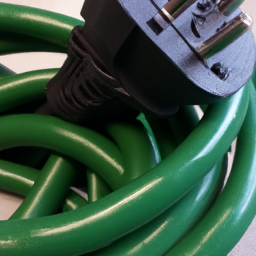We're an affiliate
We hope you love the products we recommend! Just so you know, we may collect a share of sales or other compensation from the links on this page. Thank you if you use our links, we really appreciate it!
If you own a corded electric leaf blower and find yourself in need of a power cord replacement, you’ve come to the right place. Corded electric leaf blowers are an affordable option, but their performance is limited by the length of their power cord. In this article, we will provide you with all the information you need to know about replacing the power cord for your corded electric leaf blower. From understanding the best CFM (cubic feet per minute) for different types of leaf blowers to the price range you can expect, we’ve got you covered. So, let’s get started and ensure you can continue to enjoy the efficiency and convenience of your electric leaf blower!
Understanding your Corded Electric Leaf Blower
If you own a corded electric leaf blower, it’s important to have a good understanding of its specifications, the various parts that make up the blower, and how the power cord functions. This knowledge will not only help you better maintain your leaf blower but also troubleshoot any power cord issues that may arise. In this comprehensive article, we will explore all aspects of your corded electric leaf blower to ensure that you have a seamless experience with this essential gardening tool.
Specifications of a Corded Electric Leaf Blower
Before diving into the details of your leaf blower, let’s take a look at its specifications. Corded electric leaf blowers are powered by an electric motor that needs to be plugged into an outlet. They are known for their affordability, making them a popular choice among homeowners. The best CFM (cubic feet per minute) rating for a corded electric leaf blower is generally around 150 CFM. When considering purchasing a corded electric leaf blower, it’s essential to keep in mind the price range, which typically varies from around $20 to $100.
Identifying Parts of the Leaf Blower
To effectively troubleshoot any power cord issues, it’s crucial to familiarize yourself with the various parts of your corded electric leaf blower. The main components include the motor, blower tube, power switch, and of course, the power cord itself. Understanding these parts will help you navigate through the troubleshooting process with ease.
How the Power Cord Works
The power cord is the lifeline of your corded electric leaf blower. It supplies the necessary electrical current to the motor, making it functional. The power cord is designed to be plugged into a standard electrical outlet, providing a continuous flow of power. It’s important to handle the power cord with care and be aware of any potential issues that may arise.
Detecting Power Cord Problems
Over time, power cords can experience wear and tear, resulting in various issues. By being aware of the early signs of cord problems, you can address them before they escalate into major concerns. Regularly testing and inspecting the power cord will allow you to identify cord damage promptly.
Early Signs of Cord Problems
Detecting power cord problems early on is crucial for the longevity and performance of your leaf blower. Look out for any fraying or exposed wires on the cord. If you notice any cuts, cracks, or kinks in the cord, it’s a clear indication of potential damage. Additionally, if you experience intermittent power or the leaf blower frequently shuts off during operation, it could be due to a faulty power cord.
Testing the Power Cord
To determine if your power cord is functioning properly, you can perform a simple test. Start by unplugging the leaf blower from the power source, and carefully inspect the cord for any visible damage. Once you have confirmed that the cord appears to be in good condition, plug it into a known working electrical outlet. If the leaf blower powers on without any issues, you can conclude that the power cord is working correctly.
Confirming Cord Damage
If you have detected visible damage or experienced issues during the power cord test, it’s essential to confirm the extent of the damage. In some cases, the damage may only be superficial, and a repair can easily rectify the issue. However, if the damage is severe or affects the internal wiring, it may be necessary to replace the power cord entirely.
Safety Measures before Replacing
Before proceeding with any replacement work, it’s crucial to take a few safety measures. These precautions will ensure that you minimize the risk of accidents and injuries during the process.
Properly Unplugging the Device
To ensure your safety, it’s important to properly unplug the leaf blower before beginning any work. This involves turning off the power switch and disconnecting the power cord from the electrical outlet. By following these steps, you eliminate the risk of electric shock while handling the device.
Handling of Damaged Cord
If you have confirmed damage to the power cord, it’s important to handle it with caution. Avoid any direct contact with the damaged area to prevent any potential electrical shocks. Additionally, it’s advisable to wear protective gloves to further protect yourself while working with the cord.
Securing Work Area
Creating a safe work environment is crucial when replacing a power cord. Ensure that your work area is clean, well-lit, and free from any obstructions. By removing any potential hazards, you minimize the risk of accidents and allow yourself ample space to carry out the replacement process effectively.
Acquiring Replacement Power Cord
Once you have assessed the damage and confirmed the need for a replacement power cord, it’s time to acquire the necessary part. Understanding the power cord’s specifications, knowing where to purchase replacements, and choosing the right cord for your leaf blower are important factors to consider.
Understanding Power Cord Specifications
Each leaf blower model may have specific requirements when it comes to power cord specifications. It’s crucial to refer to the manufacturer’s guidelines or the leaf blower’s user manual to ensure you select the correct replacement cord. Pay attention to details such as cord length, wire gauge, and plug type to ensure compatibility.
Where to Buy Replacement Cords
Replacement cords for corded electric leaf blowers can be found in various hardware stores, home improvement centers, and online marketplaces. Look for reputable sellers or authorized dealers to ensure you purchase a genuine and reliable replacement cord. Reading customer reviews and ratings can also be helpful in making an informed decision.
Choosing the Right Cord
When selecting a replacement power cord, it’s important to consider its durability, flexibility, and overall quality. Look for cords made from high-quality materials that are designed to withstand outdoor conditions. Additionally, opting for a cord with a length appropriate for your specific needs will provide you with optimal convenience during operation.
Removing the Old Power Cord
Now that you have the replacement power cord in hand, it’s time to remove the old one from your leaf blower. The following steps will guide you through a safe and efficient cord removal process.
Gathering Necessary Tools
Before beginning the disassembly process, gather the necessary tools to remove the old power cord efficiently. You may require a screwdriver, wire cutters/strippers, electrical tape, and potentially other tools depending on the leaf blower model. Having these tools readily available will streamline the cord removal process.
Follow Disassembly Process
Referencing the leaf blower’s user manual or manufacturer’s instructions, carefully disassemble the components necessary to access the power cord. This may involve removing screws, disconnecting wires, or detaching specific parts. Take your time and ensure each step is performed accurately and safely.
Properly Detaching the Cord
Once you have gained access to the power cord, it’s crucial to detach it properly to avoid damaging any internal components. Follow the manufacturer’s instructions or refer to the user manual for guidance on disconnecting the cord. Take note of the cord’s original routing and any clips or connections that may need to be undone.
Installing the New Power Cord
With the old power cord successfully removed, it’s time to install the replacement cord. Following step-by-step instructions and adhering to the recommended guidelines will ensure a smooth installation process.

Step-by-Step Installation Process
Begin by routing the new power cord along the same path as the old cord, ensuring it is not pinched or twisted. Make any necessary connections or secure the cord using clips or fasteners as per the manufacturer’s instructions. Take caution to avoid any potential interference with other components during the installation process.
Properly Connecting the Cord to the Machine
Carefully connect the replacement power cord to the appropriate terminals or ports within the leaf blower. Ensure the connections are secure and accurately aligned to prevent any electrical issues. Double-check the manufacturer’s guidelines to ensure correct attachment.
Verifying Correct Installation
Before fully reassembling the leaf blower, it’s crucial to verify that the replacement power cord has been installed correctly. Perform a visual inspection of the cord to ensure it is properly routed and securely connected. Take note of any loose connections or potential obstructions that may affect the cord’s performance.
Testing the New Power Cord
Once you have confirmed the correct installation of the replacement power cord, it’s time to test its functionality. Conducting a safety check, followed by an initial plug-in and test, will ensure that the new cord is working as intended.
Conducting a Safety Check
Before plugging in the leaf blower, perform a safety check to ensure that all components are properly reassembled, and there are no loose wires or potential hazards. Inspect the cord for any signs of damage or irregularities. Once you are confident in the leaf blower’s safety, you can proceed with the test.

Initial Plug-in and Test
Carefully plug the replacement power cord into a known working electrical outlet. Turn on the leaf blower and observe its operation. Check for any abnormal sounds, fluctuations in power, or any other indicators that the new cord may not be functioning correctly. If everything appears to be in order, move on to the final step.
Detecting Potential Issues with New Cord
In rare instances, despite the correct installation and initial test, a new power cord may still present issues. If you notice any irregularities, such as intermittent power, sudden shut-offs, or unusual noises, it’s important to investigate further. Refer to the troubleshooting guide for common power cord problems or consider seeking professional help if necessary.
Common Problems after Power Cord Replacement
After replacing the power cord, there may be certain issues that you may encounter. By being aware of these common problems, you can be better prepared to address them effectively.
Identifying Common Issues
Some common issues that may arise after power cord replacement include intermittent power, reduced power output, or loose connections. Additionally, improper cord routing or inadequate attachment can also lead to performance issues. Being familiar with these potential problems will assist you in troubleshooting and resolving them swiftly.
Troubleshooting Guide for Common Problems
Having a troubleshooting guide specifically tailored for common power cord problems is a valuable resource for any leaf blower owner. This guide will outline steps to address common issues, such as repositioning the cord, tightening connections, or adjusting components. Following these troubleshooting steps will help resolve any problems you may encounter.
When to Seek Professional Help
While many power cord issues can be resolved through DIY troubleshooting and replacement, there may be instances where professional assistance is required. If you are unsure of how to address a specific issue or if it involves intricate electrical work, it’s best to consult a professional technician or contact the manufacturer for guidance.
Maintaining the Power Cord of Your Leaf Blower
To prolong the life of your power cord and ensure its optimal performance, it’s important to incorporate regular maintenance practices into your leaf blower care routine.
Daily Maintenance Tips
Inspect your power cord for any signs of wear, cuts, or damage before each use. Avoid dragging the cord across rough surfaces or exposing it to excessive heat. Additionally, ensure the cord is properly stored when not in use to prevent tangling or any potential damage.
Do’s and Don’ts with Power Cords
DO handle the power cord with care, avoiding any direct contact with damaged areas. DO regularly inspect the cord for signs of wear and tear. DO store the cord properly when not in use. DON’T expose the cord to excessive heat or chemicals. DON’T use the cord as a means to transport or pull the leaf blower.
Preventing Cord Damages
To prevent power cord damages, take caution while using your leaf blower. Avoid running over the cord while operating the device, and be mindful of any potential hazards that may cause damage. Routinely inspecting the cord and promptly addressing any issues will also contribute to its longevity.
Knowing When to Upgrade to Cordless or Gas-Powered Leaf Blowers
While corded electric leaf blowers offer affordability and convenience, there may come a time when you need to consider upgrading to a cordless or gas-powered leaf blower. Understanding the differences between these types of leaf blowers, identifying your specific needs and preferences, and estimating costs will help you make an informed decision.
Comparing Corded, Cordless, and Gas-Powered Leaf Blowers
Corded, cordless, and gas-powered leaf blowers each have their own advantages and limitations. Corded electric leaf blowers are typically the most affordable option but may be limited by the length of the power cord. Cordless electric leaf blowers offer portability but have a shorter runtime due to battery limitations. Gas-powered leaf blowers are the most powerful but come at a higher cost and are more polluting.
Identifying Your Needs and Preferences
Consider your specific requirements before deciding on the type of leaf blower to upgrade to. Assess factors such as the size of your yard, the frequency of use, available power sources, and environmental considerations. Understanding your needs and preferences will help you choose the leaf blower that best suits your requirements.
Estimating Costs for Each Type
When upgrading to a new leaf blower, it’s important to estimate the costs associated with each type. Corded electric leaf blowers are generally the most affordable option in terms of purchase price, while cordless electric leaf blowers might require additional costs for spare batteries or chargers. Gas-powered leaf blowers tend to have a higher upfront cost, considering the price of the unit and the ongoing expense of gasoline.
Choosing the Best Leaf Blower for You
After considering all the factors, it’s time to make the decision that best aligns with your needs and preferences. Select a leaf blower that offers the desired power, runtime, and convenience based on your specific circumstances. Choosing the best leaf blower for you will ensure that your gardening endeavors are efficient and enjoyable.
In conclusion, understanding your corded electric leaf blower is essential for maintaining its performance and addressing any power cord issues effectively. By familiarizing yourself with the specifications, identifying the various parts, learning how the power cord works, and following the outlined steps for replacement, you can ensure a seamless experience with your leaf blower. Regular maintenance, adherence to safety measures, and knowing when to upgrade will further enhance your leaf blowing experience. With this comprehensive article as your guide, you can confidently navigate the world of corded electric leaf blowers and keep your yard clean and tidy effortlessly.




